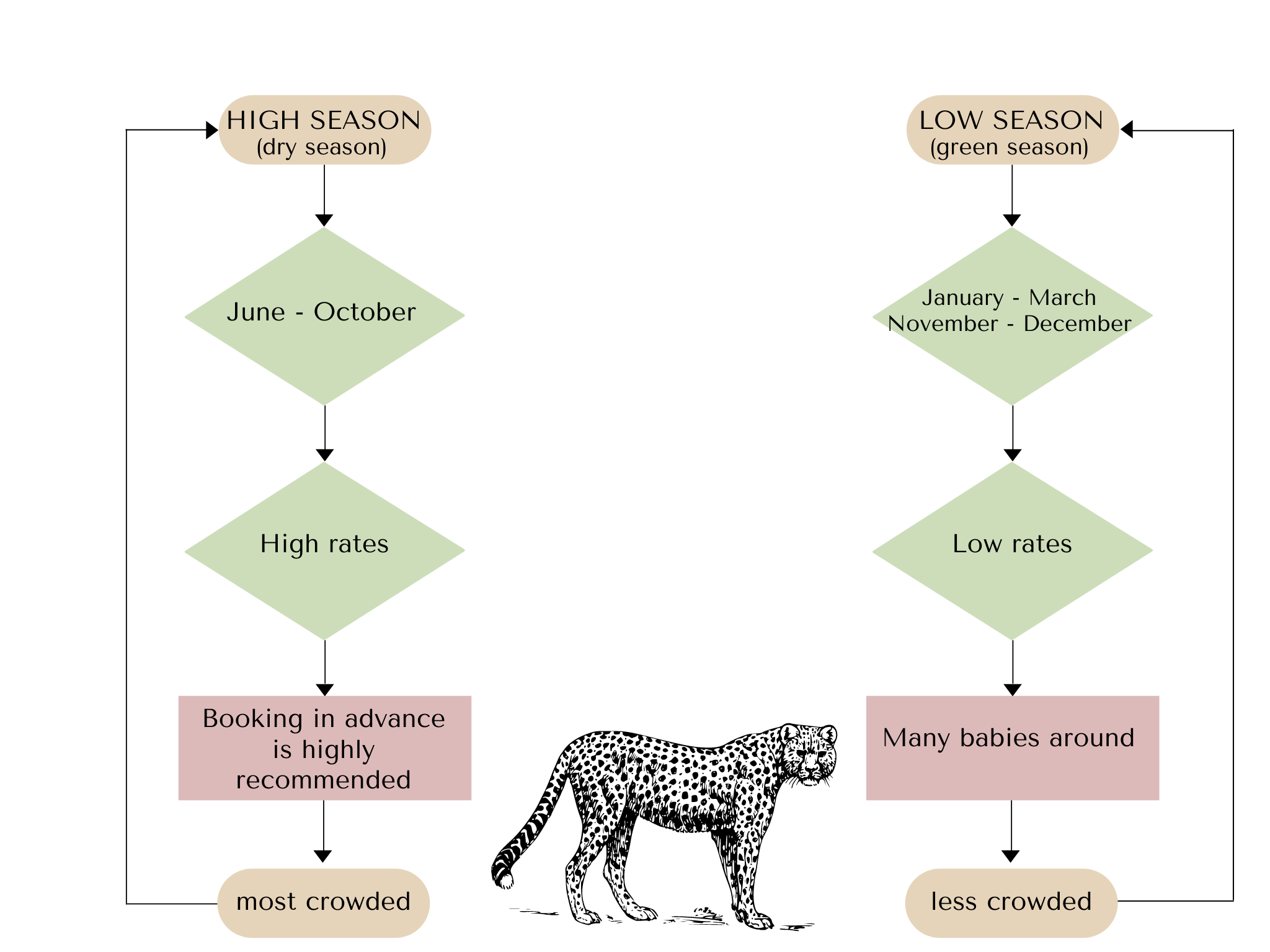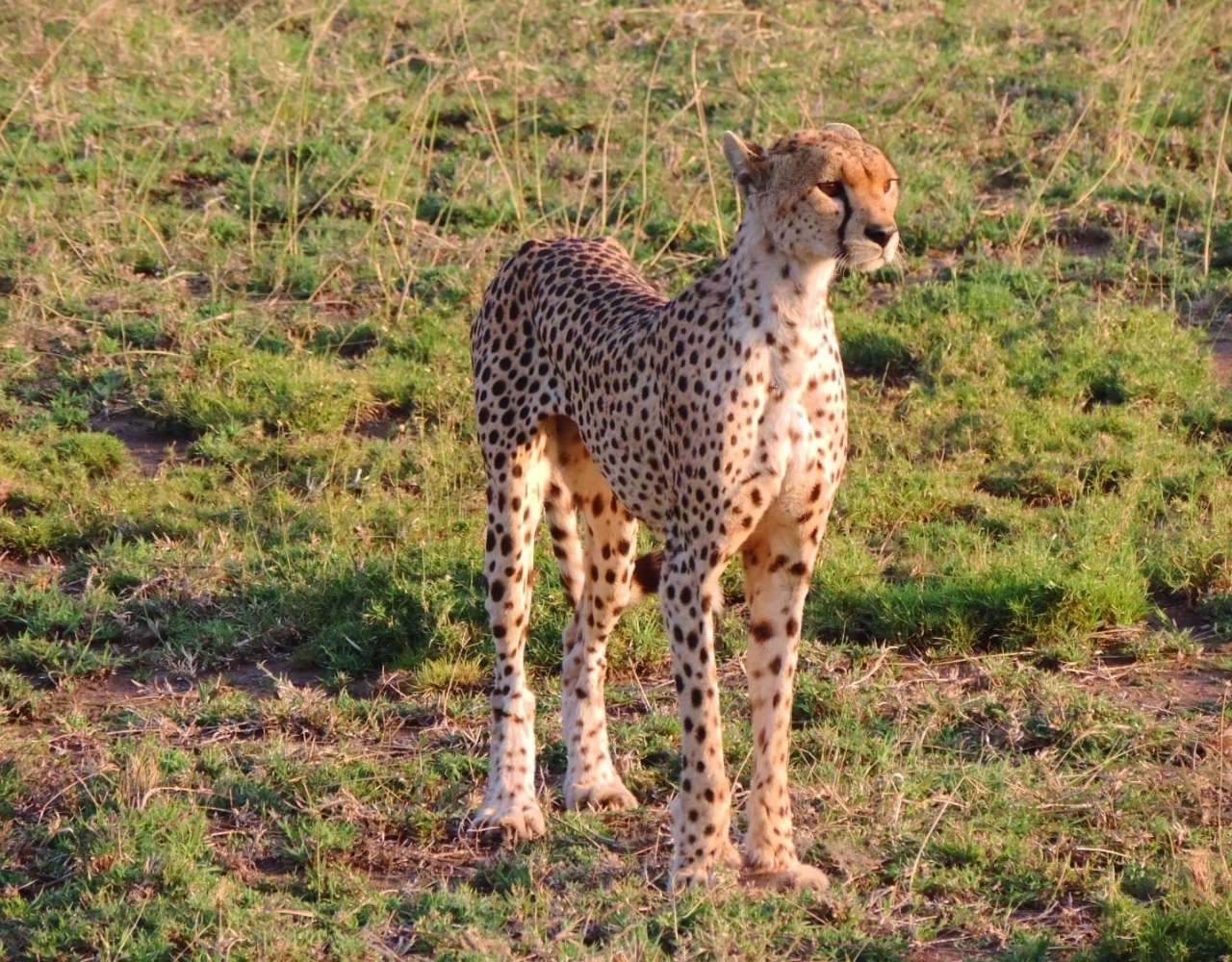WILDLIFE AREAS
More than almost any other destination Tanzania is the land of safaris. The Northern circuit is one the most popular safari circuits of Africa and includes the Serengeti, Ngorongoro Crater, Kilimanjaro National Park, Lake Manyara, Tarangire National Park and Arusha National Park.
Tanzania’s tropical climate is relatively constant all year due to the country’s proximity to the equator. Daytime temperatures usually range from 25°C to 32°C with early mornings and evenings feeling noticeably cooler. Nevertheless it is Important to note that each season varies in regard of planning a safari.

ARUSHA NATIONAL PARK
Arusha National Park includes the surrounding area of Arusha, the most famous departure-point for safaris in the northern circuit of Tanzania. The park is a scenic and diverse area, characterized by lakes, waterfalls, mountains, volcanos and tropical rainforest. Arusha National Park is a perfect day trip and offers the possibility to spot various bird species as well as buffalos, giraffes, zebras and the famous black and white colobus monkey. Mount Meru, with an elevation of 4566 meters (14,990 feet), is the second largest mountain in Tanzania and is also located within the area of Arusha National Park. The ascent of Mount Meru is beautiful, but very challenging and can be done within 2-3 days. Otherwise, Arusha National Park is known for different excursions like waking safaris, canoeing and cultural tours.

TARANGIRE NATIONAL PARK
Tarangire National Park - the name of the park originates from the Tarangire River that crosses the park and offers a source of water to a huge variety of animals. Specially during dry season, the Tarangire River is a popular meeting point and lifeline for all kind of animals. Although the park, with a size of around 2900 square kilometers, is a lesser-known park in the northern circuit of Tanzania, it is famous for two African giants: elephants and the great baobab trees. Specially the migration of around 3000 elephants from July to October is a once in a lifetime experience. The Tarangire National Park has the most varied landscape of northern Tanzania, with both - majestic baobabs, many sunlit termite mounds - as well as grassy savannas and extensive swamps. The best time to visit Tarangire National Park is maybe between June and October, during the dry period. Wildlife in the park is various and depends on the season.

LAKE MANYARA NATIONAL PARK
Lake Manyara is located just next to Tarangire National Park and is famous for its tree-climbing lions. The park's lions tend to climb trees far more often than lions in the Serengeti or Tarangire National Park. This phenomenon has baffled scientists and left them without any explanations for this event. In green season two thirds of the park is covered by lake`s water and offers a huge diversity of birds the perfect living conditions. The lake regularly turns pink due to the thousands of flamingos that are attracted by the lake`s algae. In the 330 square meter relatively small national park, visitors are able to spot more than 400 species of birds which makes it the perfect location for bird enthusiasts. Predators are also present within the Lake Manyara National Park, though seen more rarely. The best time to visit Lake Manyara for game drives is between July to October, whilst bird watchers will find the best conditions between November and May.

NGORONGORO CRATER
The Ngorongoro Crater, in the heart of the Ngorongoro Conservation area, is the world`s largest inactive caldera and a heaven for game viewing. The crater floor covers around 260 square kilometers and is more than 600 meters deep. The Maasai have given Ngorongoro its name, meaning “the black hole”. The Ngorongoro Crater, on the other hand is also called the “Eden of Africa” or “the cradle of life”, which are undoubtfully good descriptions for this magnificent piece of land. Not for nothing the crater holds Africa`s Big Five in the continents most dramatic setting. A big variety of cats, as well as huge tusker elephants and a large population of black rhino are the major highlights.

SERENGETI NATIONAL PARK
The Serengeti is the jewel in Tanzania`s crown and a genuine contender for the best wildlife experience in the world. The Serengeti is the Africa that we all have in our minds – endless grass plains stretching as far as the horizon, punctuated only by the odd flat-topped acacia tree. Serengeti National Park is arguably one of these places on earth which exceeds your imagination – this is Big Five game viewing territory. The Serengeti`s immense natural beauty and biodiversity is known all around the world and attracts year-round thousands of tourists.

THE GREAT MIGRATION
A better representation of the circle of life probably cannot be found anywhere else in the world. The journey starts in Southern Serengeti when wildebeest calves are being born. Predators like lions and hyenas are constantly hunting for babies, and thousands and thousands of calves are born within a couple weeks of each other – a feast for the eyes of true wildlife enthusiasts.
When the drought comes in May, the herd moves north, towards the Masai Mara in Kenya, chomping down the high green grass, quickly followed by the gazelles and zebras. The migration is not without risk: crossing rivers means facing about 3,000 crocodiles, patiently waiting for a kill. Not to mention the famous Serengeti lion population: by far the largest in Africa. Despite the abundance of hoofed meat in this area, life is not easy for these big cats in this unforgiving landscape. But seeing a group of lions collaborating to hunt down a wildebeest is an unforgettable sight.
Then, with the beginning of the short rains in late October, the migration makes its way back into the Serengeti. By December, the herds trek past Seronera - a small settlement in central Serengeti where the official Serengeti Visitors’ Centre is located - to return to their calving grounds again, and the circle is complete.
When planning your Serengeti safari you probably want to include seeing the Great Migration. So how do you ensure to be there when it happens? The long and short of it is that you can’t. It is important to realize that the decision of when to visit the Serengeti always involves an element of risk. We have detailed the Great Migration below, and this is what usually happens, but keep in mind that there are no guarantees.
The Great Migration cycle breaks up into the following periods:
» December-April «
We can find the main calving grounds in the area southeast of Seronera: typical Serengeti plains stretch all the way to the Ndutu area near Ngorongoro. Triggering their move to this area are the short rains in November and December. The wildebeest stick around this area until the end of the long rains, end of April, early May. The delightful news is that this section of Serengeti National Park is easily accessible and that in this period the landscape becomes lush. February is usually calving season in the Ndutu area and the southeastern plains: the very best time to visit this area. As wildebeest, zebra and other ungulates are so many, and give birth to so many calves, the spectacle works as a magnet for predators. As early as March or April the herd may move again in search of greener pastures. Seeing the actual migration in this period is more difficult, but chances are that you will encounter very large herds on the move.
» May - July «
This is the period that the wildebeest, after having feasted on the short green grasses of the southeastern Serengeti and after having giving birth to their offspring, start getting ready for their 800 kilometer long trek. The actual starting date may be anytime between late April and early June. This is the time to you may have the privilege to see one of the greatest natural phenomena in the world: more than a million marching animals in a column up to 40 kilometers long. During the migration, the herd will move towards the Western Corridor, where they will face the first major obstacle: crossing the Grumeti River. Many animals don’t survive the crossing as they are being awaited by the area’s population of oversized crocodiles ready to feast. The herd may congregate on the southern bank of the river and stay there for up to two weeks before crossing the river.
» August - September «
When the Grumeti River obstacle has been taken, the herd moves further north and starts crossing the next big hurdle, the Mara River, in July or August. The Mara River crossing is where so many iconic Great Migration photos have been taken. After this crossing the herd flocks to the northwest plains and Masai Mara National Reserve in Kenya. The August – September period is considered being a bad time to visit Serengeti National Park and see the Great Migration as the herd moves into the Masai Mara in Kenya. However, migration patterns show that about half of the herd stays on the Tanzanian side, in the Mara Serengeti area. In this period, smaller herds of wildebeest (well consider small… herds may count up to between 500 and thousands of individuals) frequently cross the Mara River, back and forth, for no apparent reason. This is an excellent time to stay at one of the Serengeti Mara camps.
» October - November «
Crossing the Mara River northbound means that, at one point, the herd needs to cross the river one more time before commencing the trek back in a southerly direction. This usually happens in October, but sometimes earlier. In this period the herd will cross the northern plains and Lobo area. This section of Serengeti National Park is little-visited, so if you are looking to see the migration in relative quietness, this would be the time. The wildebeest return to the short- grass plains and calving ground around Ndutu in late November. And from here, the Great Migration starts all over again.
SEASONS
Tanzania is a vast ecosystem with many seasonal differences in terms of weather and climate.
The various National Parks experience a generally cool and and dry season from May to August; a dry and warmer season in September and October; and a wetter and hot season from November to April. Although popular image dictates that Africa is mostly a very hot place, Tanzanias climate is actually very pleasant and moderate. It seldom gets uncomfortably hot, and temperatures drop during the night and early mornings. The minimum and maximum temperatures vary with the seasons, with the wet season being the warmest. Temperatures rarely exceeds 37 °C on a hot afternoon in the rainy season, and hardly ever dips below 13 °C on a cold early morning in the dry season. There are two rainy periods in Serengeti National Park. The short rains from November to December are the first to break the grip of the dry season. These rains are unpredictable and are unlikely to interfere with your safari. The long rains follow the short rains in the period from March to May, which are the highest rainfall months. It seldom rains for the entire day, but please remember that it rains on most days. For first-time safaris we would recommend the long dry season from June to October, as wildlife is easier to track and spot.
Nevertheless, each season has its wonderful experiences to offer and the landscapes will vary significantly. If possible, you want to avoid planning safaris as mentioned in March, April and May as those 2-3 months are the long rain months and rain might play a big role during your safari.
HIGH SEASON VS. LOW SEASON

"What our clients say ..."





















































